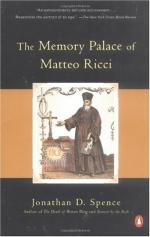
|
| Name: _________________________ | Period: ___________________ |
This test consists of 15 multiple choice questions and 5 short answer questions.
Multiple Choice Questions
1. What did Ricci help the Chinese to see with this second picture "The Road to Emmaus"?
(a) The Chinese will understand the role of salvation in the lives of Christians.
(b) The Chinese will see two men accepting the resurrection of God and the third preparing for His return to heaven.
(c) The Chinese will see the wonder of the resurrection and its effect on Christ's followers.
(d) The Chinese will understand the power of Jesus to perform miracles.
2. Why did Ricci wish he had more money during the 16th century when he was in China?
(a) To build a new church for his Christian converts.
(b) To buy books to further his plans for the conversion of the Chinese people.
(c) To provide more financial resources to the impoverished Chinese farmers.
(d) To bribe government officials to leave his mission alone.
3. According to "Chapter Eight, The Fourth Image: The Fourth Picture", what doctrine were the Chinese not ready to understand when Ricci was a missionary in 16th century China?
(a) The Assumption.
(b) The Incarnation.
(c) The Epiphany.
(d) The Resurrection.
4. When Ricci divided the fourth ideograph, "hao," what was the new meaning?
(a) "Woman" and "child" created a reference to the Virgin Mary.
(b) "Man," "woman," and "child" created a reference to the Holy Family.
(c) "Woman" and "girl" created a reference to Mary's virginity.
(d) "Man" and "woman" created a reference to the marriage of Mary and Joseph.
5. Where did Ricci place the new picture of the fourth idiograph "hao" in the Memory Palace?
(a) In the southwest corner of the garden.
(b) In the nursery on the second floor.
(c) In the southwest corner of the reception hall.
(d) In the barn just outside the back door.
6. What did Ricci NOT like about the Confucian moral system when he was a missionary in the 16th century?
(a) Its approval of animal sacrifice.
(b) Its pantheism.
(c) Its ideas about the role of women.
(d) Its subjugation of children.
7. According to "Chapter Five, The Second Picture: The Road to Emmaus", what did Ricci teach to the Chinese that he compared to branches of a stream?
(a) Language.
(b) Agriculture.
(c) Mathematics.
(d) Science.
8. During the Renaissance, why were the Jesuits NOT considered a mendicant order?
(a) They did not engage in teaching assignments.
(b) They did not practice obedience to the Pope.
(c) They did not live in poverty.
(d) They did not practice chastity.
9. Why did Ricci alter the story of the third picture, "The Men of Sodom"?
(a) To communicate the idea that man is sinful.
(b) To communicate the idea that sin brings God's judgment.
(c) To communicate the idea that woman tempts man into sin.
(d) To communicate the idea that God is merciful.
10. Who was depicted in the second picture "The Road to Emmaus" that Ricci showed Cheng Dayue?
(a) Six apostles.
(b) Christ and two disciples.
(c) Two disciples.
(d) Christ, his mother, and two disciples.
11. What was the meaning of the third idiograph chosen by Ricci?
(a) Loss.
(b) Benefit.
(c) Gain.
(d) Profit.
12. When Ricci was a missionary in 16th century China, whom did the Chinese people fear?
(a) Jesuit missionaries.
(b) The Chinese ruler.
(c) Foreign invaders.
(d) Buddhist monks.
13. According to "Chapter Eight, The Fourth Image: The Fourth Picture", what effect did Ricci's reflections on the Virgin Mary have on him?
(a) They provide him with Chinese friends.
(b) They give him solace.
(c) They make him nervous.
(d) They make him sad.
14. During the Renaissance, what was the name of the groups in China that "pledged themselves to lives of heightened spiritual service"?
(a) Marian sodalities.
(b) Roman monasteries.
(c) Catholic Chinese unions.
(d) Christian conservatives.
15. During the 16th century, how did the way Ignatius Loyola wanted students to learn affect Matteo Ricci?
(a) Ricci chose to become a Jesuit.
(b) Ricci argued with his instructors about the method's futility.
(c) Ricci developed his mnemonic technique.
(d) Ricci rose to the top of his class.
Short Answer Questions
1. According to "Chapter Six, The Third Image: Profit and Harvest", what was the next idiograph that Ricci chose?
2. Who or what urged penalties on Christians who participated with the Japanese in the Japanese use of financial tricks to make money during the 16th century?
3. When Ricci became a missionary in China during the 16th century, what was he able to do in five months?
4. What type of life was flourishing during the 16th century when Ricci was in China?
5. What problem arose because of the type of life that was flourishing during the 16th century when Ricci was in China?
|
This section contains 769 words (approx. 3 pages at 300 words per page) |

|




